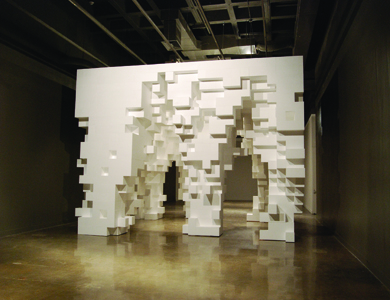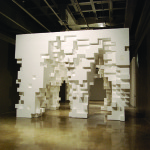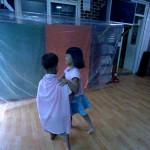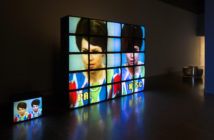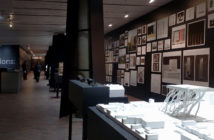It seems fitting that Tobias Putrih and MOS (an architectural collective) have their recent piece Without Out installed at MIT. If for no other reason that it’s aesthetic certainly reflects a couple of buildings not only on the MIT Campus, but also in the Boston Area (Boston City Hall, MIT’s Stratton Student Center and Dewey Library). These buildings are examples of the Brutalist style of architecture, a style that Putrih and MOS certainly evoke in their sculptural work. They build architectural spaces using Styrofoam and plywood. Their structures are blocky and appear to be constantly on the verge of collapse.
It is clear that this is the space that the artists are mining. Alongside the installation at the LIST is a small stack of monitors displaying the artist and a group of assistants attempting to build a structure with foam blocks. They try again and again to raise the structure only to have it collapse on them. It proves great insight to the design skill that went into the creation of Erosion. The piece takes up much of the gallery space and looms over you as you enter. The stark white of the Styrofoam sharply contrasts the grey walls. Like I said before it immediately makes one (or maybe just me) think of the weighty, concrete forms that are reminiscent of Brutalism. The work is formally a large white cube. However, the artists have removed many of the internal pieces in an attempt to illustrate how much can be removed before the structure collapses. It is simultaneously a deteriorated space and a functional one. According to the essay by LIST Director Jane Farver, Erosion was designed using MOS’s stacking software only “in an inverted manner. Instead of adding blocks, the software eroded and dug into an existing pile by first creating negative space – a cave – and by eroding it further toward the point of collapse.” It really is a piece that blurs the line between sculpture and architecture. One could say, however, that this is a space that is pretty commonly blurred although not as often in a gallery. One only needs to take a look at contemporary architecture to see sculptural elements. Architects are finally able to think beyond physical limitations thanks to complex computer modeling (take one look at Gehry’s Stata Center for one example).
What I really found interesting about the work was the fact that it wasn’t only referencing architecture for me. It made me think of the work of Rachel Whiteread and Anthony Gormley, two other artists who use multiples and mathematics to transform gallery spaces. So it isn’t simply an architectural piece plopped down in a gallery. It is an exploration of space and how we navigate and conceptualize it. There is a moment when walking through and under Erosion that you feel like you are transported. The sharp geometric abstractions of space disorient. To some degree I felt like I was entering a pixilated space but then maybe I spend too much time on the computer. It is subtle and complex work that I felt was right at home on the MIT campus.
In the adjoining gallery filmmaker Sung Hwan Kim is also exploring space with his piece Summer Days in Keijo – Written in 1937. This quiet, evocative film uses the work of Swedish ethnographer Sten Bergman (from 1937) to investigate space and memory. Bergman’s travelogue, In Korean Wilds and Villages details his trip across Korea looking for ethnographic objects to bring back to Sweden. At the time, Korea was occupied by the Japanese and referred to as Keijo. The original text is used as a voice-over while Kim’s contemporary protagonist, played by Dutch artist Mieke Van de Voort, traces Bergman’s steps across the city. His text leads her through the city conflating time and memory. Many of the structures described by Bergman have long been destroyed along with one (the Jong-no Saewoon Market) having been demolished since the making of the video. Initially Kim’s video is pretty straightforward. It is a tale of two times occupying one space. It flows linearly, sticking closely to Bergman’s journey. But towards the end the video becomes something else. It leaves Bergman behind and begins to tell the story of the artist and his protagonist. The video gets more abstracted and less urban but maintains the dreamlike quality of the early parts of the piece. Kim shifts vantage points throughout the video. Sometimes we are an invisible follower of the woman as she explores Korean spaces. At other times, the camera is framed and on display. We are clearly looking through a viewfinder. We are Kim and his camera. This shift serves as a reminder of the presence of the artist as he documents the non-Koreans occupying and exploring the space of his country.
I found the video to be especially poignant given my own recent observations of Korea. What is the cultural baggage one brings to another culture? While we are thankfully beyond Bergman’s cultural (and colonialist) milieu, there are still complications around the fact that when visiting another country you have to realize that it is ultimately not coded for you. I found myself critical of him and his desire for “ethnographic” material but then stopped because what was I doing in Korea? I was there to witness and engage but wasn’t my trip also ethnographic? It made me pause and reflect upon the illusions that go hand in hand with globalization: the “one world” crap that we are endlessly bombarded with. Perhaps the truth is that we are all ethnographers? We visit, and search, and absorb cultural facts. Kim’s piece brings forth some truths about contemporary cross-cultural exploration. Although the language and terminology might be different I can’t help feeling my trip echoed Sten Bergman’s, and Mieke Van de Voort’s, and possibly Kim’s.
Sung Hwan Kim will be speaking at MIT's Bartos Theatre on Wednesday, Dec 2nd at 7:30.
- Tobias Putrih & MOS, Without Out, Styrofoam and plywood, 2009.
- Sung Hwan Kim, Summer Days in Keijo – Written in 1937, Video, 2007.
"Without Out" is on view until January 3rd, 2010 at THe MIT List Visual Arts Center.
All images are courtesy of the artist and MIT List Visual Arts Center.
"Summer Days in Keijo–written in 1937" is on view until January 3rd, 2010 at the MIT List Visual Arts Center.
All images are courtesy of the artist and MIT List Visual Arts Center.

